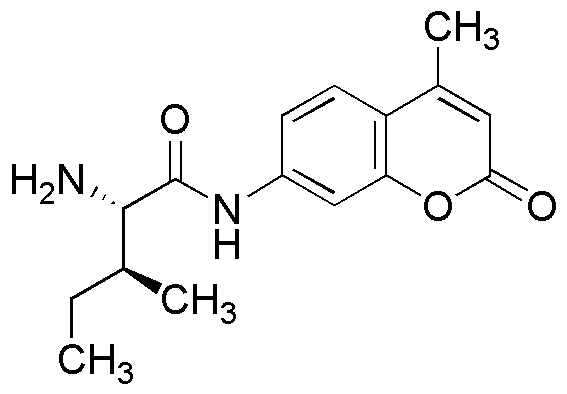L-Isoleucine 7-amido-4-methylcoumarin is widely utilized in research focused on:
- Biochemical Assays: This compound serves as a fluorescent probe in enzyme activity assays, allowing researchers to monitor proteolytic activity in real-time, which is essential for studying enzyme kinetics.
- Drug Development: It is used in the development of new pharmaceuticals, particularly in targeting specific enzymes related to various diseases, enhancing the specificity and efficacy of drug candidates.
- Cell Biology: Researchers employ this compound to study cellular processes, including protein interactions and signaling pathways, providing insights into cellular mechanisms and potential therapeutic targets.
- Fluorescent Labeling: The compound is utilized for labeling biomolecules in imaging studies, facilitating the visualization of cellular components and their dynamics under a microscope.
- Research in Metabolism: This chemical aids in metabolic studies by acting as a substrate or inhibitor, helping scientists understand metabolic pathways and their regulation in various organisms.
General Information
Properties
Safety and Regulations
Applications
L-Isoleucine 7-amido-4-methylcoumarin is widely utilized in research focused on:
- Biochemical Assays: This compound serves as a fluorescent probe in enzyme activity assays, allowing researchers to monitor proteolytic activity in real-time, which is essential for studying enzyme kinetics.
- Drug Development: It is used in the development of new pharmaceuticals, particularly in targeting specific enzymes related to various diseases, enhancing the specificity and efficacy of drug candidates.
- Cell Biology: Researchers employ this compound to study cellular processes, including protein interactions and signaling pathways, providing insights into cellular mechanisms and potential therapeutic targets.
- Fluorescent Labeling: The compound is utilized for labeling biomolecules in imaging studies, facilitating the visualization of cellular components and their dynamics under a microscope.
- Research in Metabolism: This chemical aids in metabolic studies by acting as a substrate or inhibitor, helping scientists understand metabolic pathways and their regulation in various organisms.
Documents
Safety Data Sheets (SDS)
The SDS provides comprehensive safety information on handling, storage, and disposal of the product.
Product Specification (PS)
The PS provides a comprehensive breakdown of the product’s properties, including chemical composition, physical state, purity, and storage requirements. It also details acceptable quality ranges and the product's intended applications.
Certificates of Analysis (COA)
Search for Certificates of Analysis (COA) by entering the products Lot Number. Lot and Batch Numbers can be found on a product’s label following the words ‘Lot’ or ‘Batch’.
Numéro de catalogue
Numéro de lot/série
Certificates Of Origin (COO)
This COO confirms the country where the product was manufactured, and also details the materials and components used in it and whether it is derived from natural, synthetic, or other specific sources. This certificate may be required for customs, trade, and regulatory compliance.
Numéro de catalogue
Numéro de lot/série
Safety Data Sheets (SDS)
The SDS provides comprehensive safety information on handling, storage, and disposal of the product.
DownloadProduct Specification (PS)
The PS provides a comprehensive breakdown of the product’s properties, including chemical composition, physical state, purity, and storage requirements. It also details acceptable quality ranges and the product's intended applications.
DownloadCertificates of Analysis (COA)
Search for Certificates of Analysis (COA) by entering the products Lot Number. Lot and Batch Numbers can be found on a product’s label following the words ‘Lot’ or ‘Batch’.
Numéro de catalogue
Numéro de lot/série
Certificates Of Origin (COO)
This COO confirms the country where the product was manufactured, and also details the materials and components used in it and whether it is derived from natural, synthetic, or other specific sources. This certificate may be required for customs, trade, and regulatory compliance.


